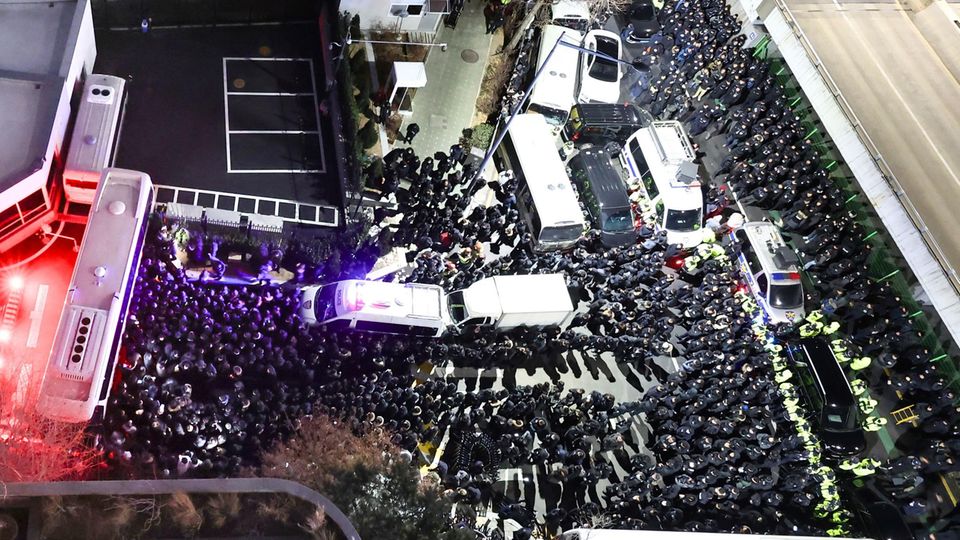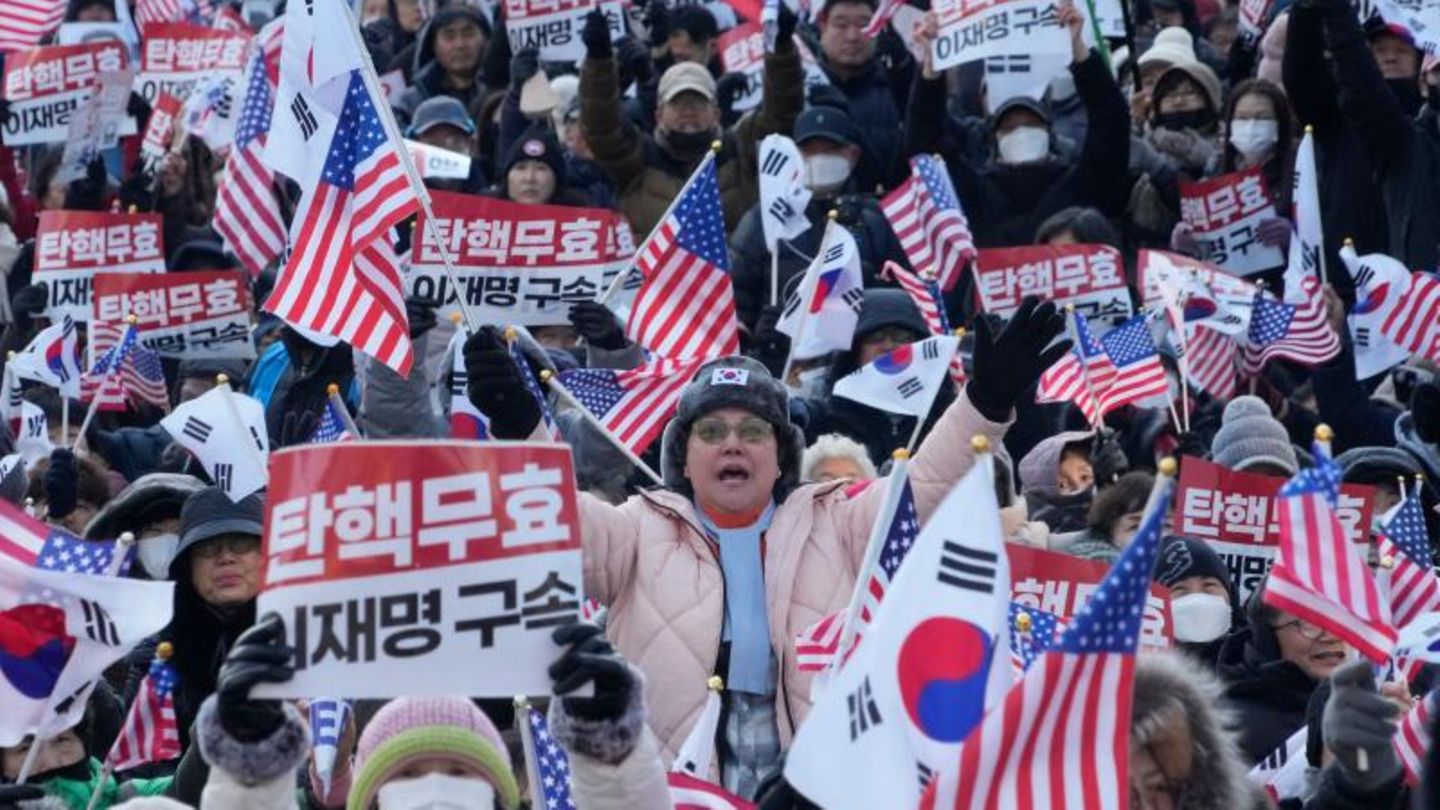Simply explained
Trump tastes in Korea – the national crisis in review
Copy the current link
The chaos in South Korea in fast forward: bickering, martial law, protests, deposition – and now arrest. If you want to know more, read this article.
Compared to what happened in Seoul on and after December 3, 2024, the traffic light shutdown in Germany looks like a botched university project.
A head of state calling for martial law with a grave face, angry people storming into the streets, soldiers surrounding parliament – the images from the South Korean capital were indeed dramatic.
What happened on the night of December 3rd to 4th, 2024?
At 10:29 p.m. Korean time, Yoon Suk Yeol appeared unannounced in front of the cameras. With his hands practically stapled to the lectern, he said without any discernible emotion:
“Dear fellow citizens, I am declaring martial law to protect the Republic of Korea from the threat of communist forces from North Korea.”
The National Assembly has degenerated into a “den of criminals”; these are “unscrupulous forces” who are “plundering the freedom and happiness of our people” and who must be “exterminated immediately”! Proofs? None.
In reality, the Conservatives, who lead a minority government, had repeatedly and recently cut their teeth on the opposition once too often in the budget dispute. Because their largest party – the Social Liberals – is actually committed to rapprochement with the evil rocket man in the north, the story of betrayal was attractive. At least that’s what Yoon hoped.
Martial law will of course “bring some inconveniences,” he said. “Please trust me,” Yoon ended his speech. The South Koreans didn’t. Instead: chaos.
The opposition Democratic Party, which alone has 170 of the 300 representatives, immediately called for an emergency meeting. But even as the politicians rushed to the Gukhoe (Parliament), the military command gave the conservative government almost absolute power. Anyone who violated the decree was to be arrested without a warrant.
To ensure that the opposition did not have the opportunity to vote on martial law, hundreds of heavily armed soldiers surrounded the parliament building, presumably on Yoon’s personal orders. The Democratic leader, Lee Jae-myung, called on South Koreans via livestream from his car to come to Parliament to pave a way for MPs to get in. The images of soldiers climbing over barricades and spraying fire extinguishers to get into Parliament and put an end to the horror went around the world:
Although soldiers even broke windows to get into the chamber and stop lawmakers, 190 of them voted unanimously to lift martial law around 1 a.m. – including 18 of Yoon’s own people. The police and soldiers had enough and left. A little later, early in the morning, the cabinet officially revoked martial law. Yoon’s rebellion, if it was one, lasted six hours.
What happens after that?
While the demonstrations on the streets really gained momentum, parliamentarians spent the following days pointing fingers. Of course the opposition wanted to get Yoon. His allies, in turn, did everything they could to prevent a vote on impeachment from even taking place.
South Korea: The hardest high school exam in the world

According to the national newspaper Korea Joong Ang Daily, 520,000 students will take the College Scholastic Ability Test (CSAT) this year, which determines their admission to university. In the Chogey Buddhist temple, parents hang notes on a wall that are supposed to bring good luck to their children.
© Chris Jung / Getty Images
Back
Further
The loyalty to duty did not last long. As early as December 6th, Han Dong-hun, the head of the conservatives, spoke out in favor of putting Yoon’s powers on hold. Ultimately, there is “a significant risk of extreme actions.” That means: Be careful, he could try again!
And what did Yoon do? First of all, he threw the man who had probably advised him to do all this in the first place at the feet of the public prosecutor’s office: his defense minister. He tried to take his own life shortly before his arrest.
Because his party leadership quickly turned away from him, Yoon turned to remorse – knowing full well that he still had enough MPs on his side. He apologized to the South Koreans in a live TV speech, but the protests continued.
The first vote on impeachment proceedings initially failed due to the necessary two-thirds majority. But the second attempt was successful. The motion passed, 204 MPs, including twelve conservatives, voted for it. Yoon, although still formally in office, lost all of his presidential powers. Han, the previous number 2, took over. At least for almost two weeks. Then he himself faced impeachment proceedings – a retaliation for Han’s refusal to appoint constitutional judges in whose hands Yoon’s political fate lies. They met this Tuesday for the first official hearing. The whole thing lasted a cigarette. Where there is no defendant, there is no judge.
How did Yoon’s arrest come about?
After Yoon repeatedly refused to appear for official questioning, a Seoul judge (separate from the Constitutional Court) issued an arrest warrant on December 31. The accusation: riot. If Yoon were found guilty, he would face the prospect of spending the rest of his life behind bars – or even death.
However, the authorities couldn’t get their hands on him. During the first, unsuccessful attempt to take the president into custody for questioning, the investigators clashed with his security forces. His guard stood by him, but the king without a throne still sat firmly. Yoon was unable to flee abroad; the Ministry of Justice kept him on the ground. Due to a lack of alternatives, the wanted man and his small army barricaded themselves behind the barbed wire walls of his property.

At some point, the people in charge apparently lost their temper. In any case, on Wednesday morning, thousands of police officers and agents from the anti-corruption agency CIO stormed Yoon’s property, armed with a fresh arrest warrant. This time the presidential security service gave in and allowed their protégé to be taken away without resistance.
Why not like that? Confusion of responsibilities. Not only the public prosecutor’s office, but also the police and the anti-corruption agency were investigating him – just each individually. They had only recently pulled together: the CIO, the smallest and youngest of the authorities, is now in charge, the police are the friend and helper, the public prosecutor’s office is looking after Yoon’s co-accused employees.
Will the investigators crack him, the former attorney general? Unlikely, especially since they only have 48 hours to ask him 200 pages of questions, as the Korea Herald reports. A new arrest warrant must then be issued. Of course, Yoon doesn’t want his current cooperation to be misunderstood. He sticks to it: He didn’t do anything wrong, he was just doing his job. The majority of conservatives, including party leadership, see it the same way. The arrest warrant is “illegal,” an instrument of the left.
Who has been in charge in South Korea since then?
Good question. The cabinet is visibly thinned out. The ministers of defense and justice as well as the head of government are suspended for their alleged involvement in whatever you want to call it.
But since December 27th, at least something resembling order has been restored – in the form of ex-finance minister and ex-Yoon loyalist Choi Sang-mok, who has taken over the post of prime minister and the duties of president on an interim basis.
It is true that he is not particularly respected in his own party or in the other parties. But it will be enough for a while. The Constitutional Court could remove Yoon from office this spring and call new elections within two months.
What’s next?
It is by no means certain that the situation will calm down with Yoon’s arrest. The South Koreans are very allergic to going it alone – the memories of the end of the military dictatorship at the end of the 80s are too fresh. South Korean democracy definitely has some wounds to lick. How deep they are remains to be seen.
In any case, the division in Korean society no longer occurs solely between North and South. The fact that Yoon supporters – egged on by ultra-right influencers – are now taking the MAGA crowd from the USA as a model and loudly adapting the Trumpian fairy tale of supposedly stolen elections does not bode well.
Source: Stern
I have been working in the news industry for over 6 years, first as a reporter and now as an editor. I have covered politics extensively, and my work has appeared in major newspapers and online news outlets around the world. In addition to my writing, I also contribute regularly to 24 Hours World.




